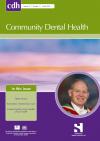Community Dental Health

- Cover Date:
- March 2015
- Print ISSN:
- 0265 539X
- Vol:
- 32
- Issue:
- 1
Tooth brushing among 11- to 15-year-olds in Denmark: combined effect of social class and migration status.
© BASCD 2015 doi:10.1922/CDH_3414Bast05
Tooth brushing among 11- to 15-year-olds in Denmark: combined effect of social class and migration status.
L.S. Bast, H. Nordah, L.B. Christensen and B.E. Holstein
Objective: Regular tooth brushing in adolescence predicts stable tooth brushing habits later in life. Differences in tooth brushing habits by ethnic background and socioeconomic position have been suggested. We investigated migration status and social class in relation to infrequent tooth brushing both separately and combined. Methods: The study population was 11-15 year-olds chosen from a clustered random sample of schools. Univariate and multivariate logistic regression analyses estimated the separate and combined effects of migration status and social class on less than twice daily tooth brushing. Results: 10,607 respondents: a response rate of 88.3%. Boys of lower social class had higher odds ratio (OR) of infrequent tooth brushing than girls: 1.98 (95% confidence interval 1.62-2.41) vs 1.80 (1.53-2.24). Immigrants and descendants had higher odds compared to adolescents of Danish origin: immigrant boys OR 1.39 (1.05-1.89), girls OR 1.92 (1.47-2.50); descendant boys OR 2.53 (1.97-3.27), girls OR 2.56 (2.02-3.35). Analyses of the combined effect of social class and migration status showed that the social gradient in tooth brushing habits observed among ethnic Danes cannot be found among groups of immigrants and descendants. Conclusion: The study shows that both non-Danish origin and low social class increases the risk of infrequent tooth brushing among school-aged children. The study calls for in depth analyses of the processes which influence young people’s tooth brushing habits. Further, there is a need to strengthen the promotion of appropriate tooth brushing habits of minority and low social class youths.
Key words: adolescents, school children, tooth brushing, social class, migration status, ethnic background, Denmark
- Article Price
- £15.00
- Institution Article Price
- £
- Page Start
- 51
- Page End
- 55
- Authors
- L.S. Bast, H. Nordah, L.B. Christensen, B.E. Holstein
Articles from this issue
- Title
- Pg. Start
- Pg. End
- Comparing lifecourse models of social class and adult oral health using the 1958 National Child Development Study
- 20
- 25
- Barriers to providing oral health care to pre-school children– differences between paediatric dentists’ and general dental practitioners’ beliefs
- 32
- 38
- Health economic analyses of domiciliary dental care and care at fixed clinics for elderly nursing home residents in Sweden
- 39
- 43
- Tooth brushing among 11- to 15-year-olds in Denmark: combined effect of social class and migration status.
- 51
- 55
- The incidence and nature of complaints against dentists for the treatment of children in Israel from 1992–2011
- 56
- 59
